Abstract
Previous work from our laboratory suggested that the selective inhibition of Epstein-Barr virus (EBV) replication by 1-beta-D-arabinofuranosylthymine in human lymphoid cell lines involved the induction of a new thymidine kinase (TK) able to phosphorylate the thymidine analog. We further characterized this enzyme induced in various EBV-positive cell lines after viral genome activation with a combination of sodium butyrate and 12-O-tetradecanoylphorbol-13-acetate. The following results confirmed the existence of an EBV-specific deoxypyrimidine kinase: induction of EBV-related TK was connected with the appearance of viral early antigens in EBV-carrying cells; unexpected behaviors of the enzyme activity upon different fractionating treatments led to the conclusion that EBV-induced TK was extracted as a complex molecular form, larger than other known cellular or viral isozymes; enzymatic properties distinguished EBV-induced TK from host lymphoid cell isozymes but made it resemble other herpesvirus-specific deoxypyrimidine kinases, i.e., by partial inhibition by dTTP or ammonium sulfate, insensitiveness to dCTP, and nonstringent specificity for normal TK substrates. Genetic evidence is required to definitively ensure that EBV-specific TK actually is virus coded in EBV-transformed human lymphoid cells.
Full text
PDF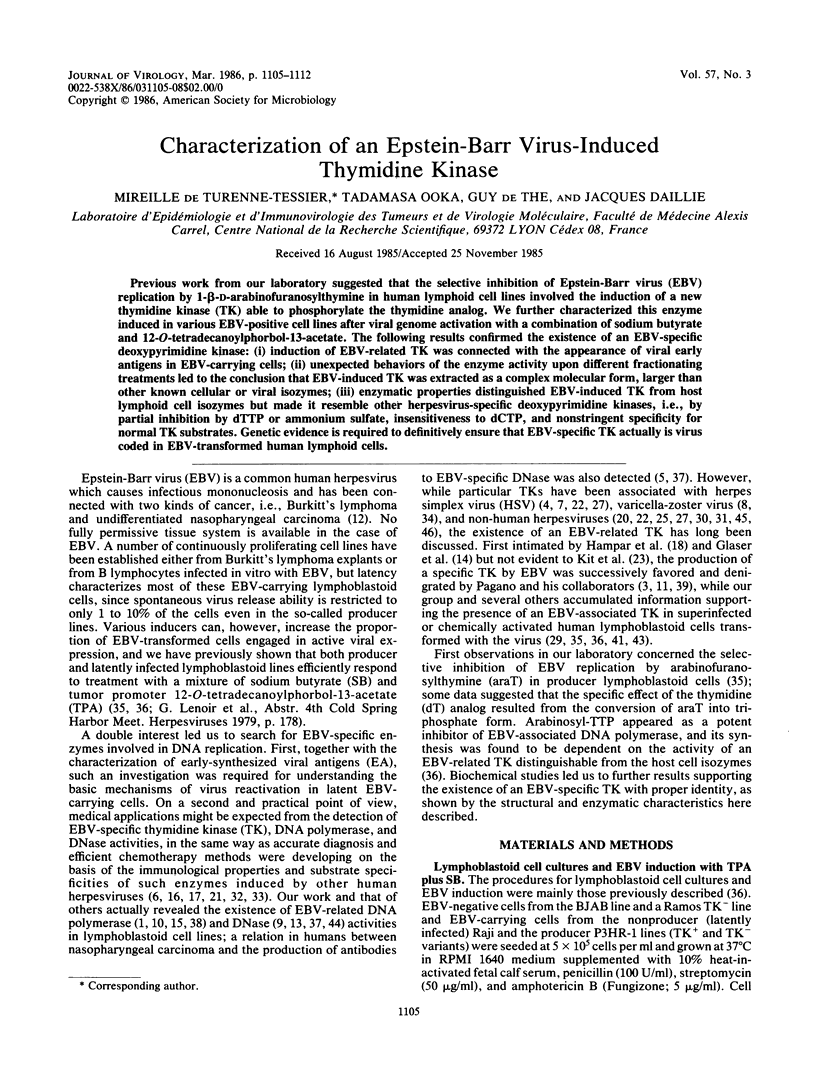
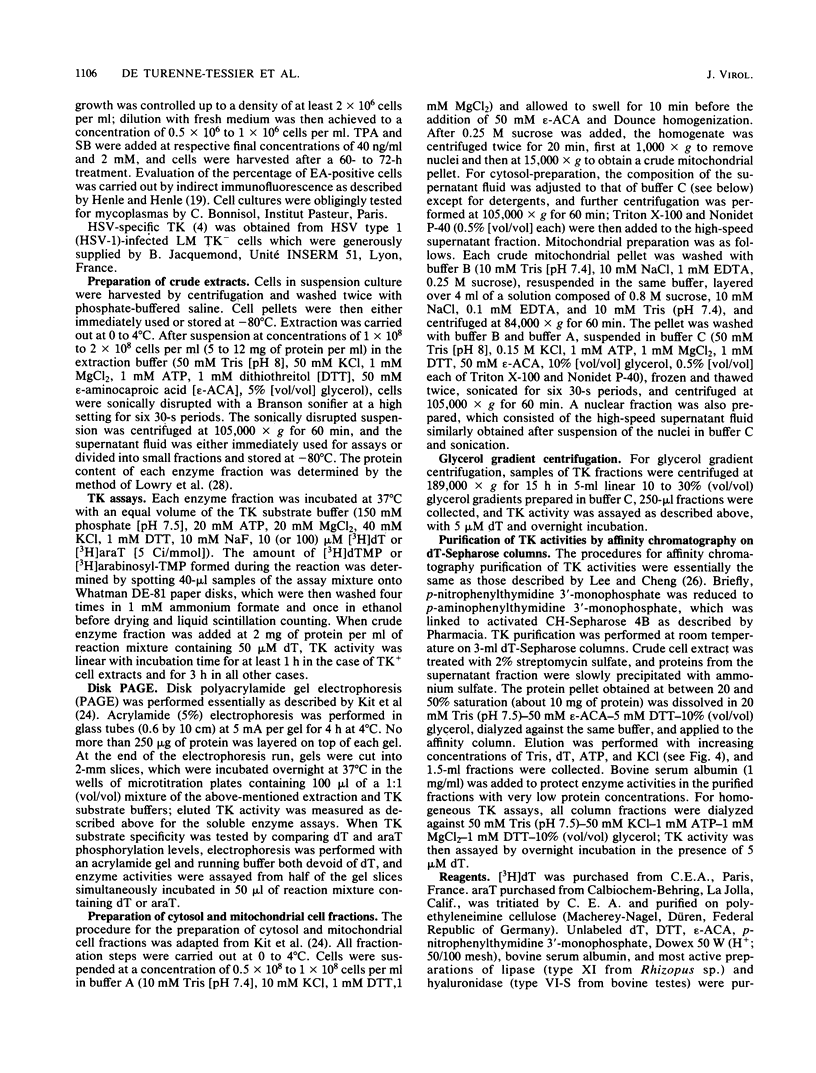
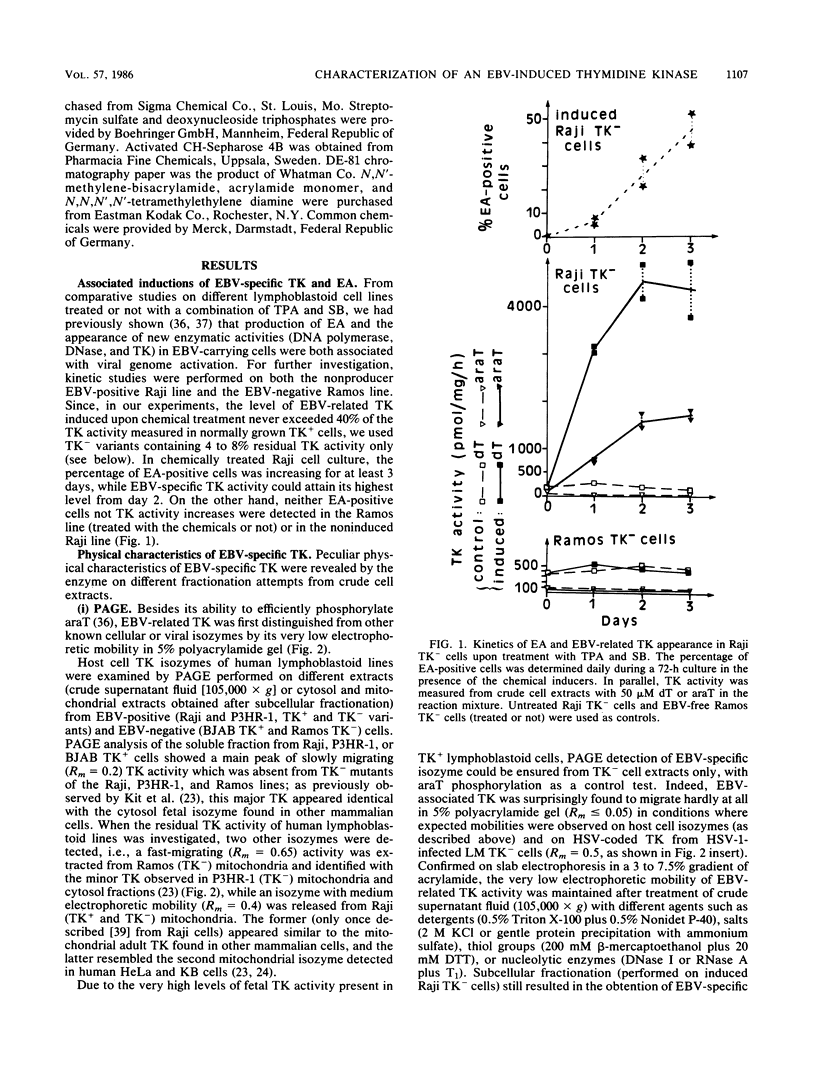
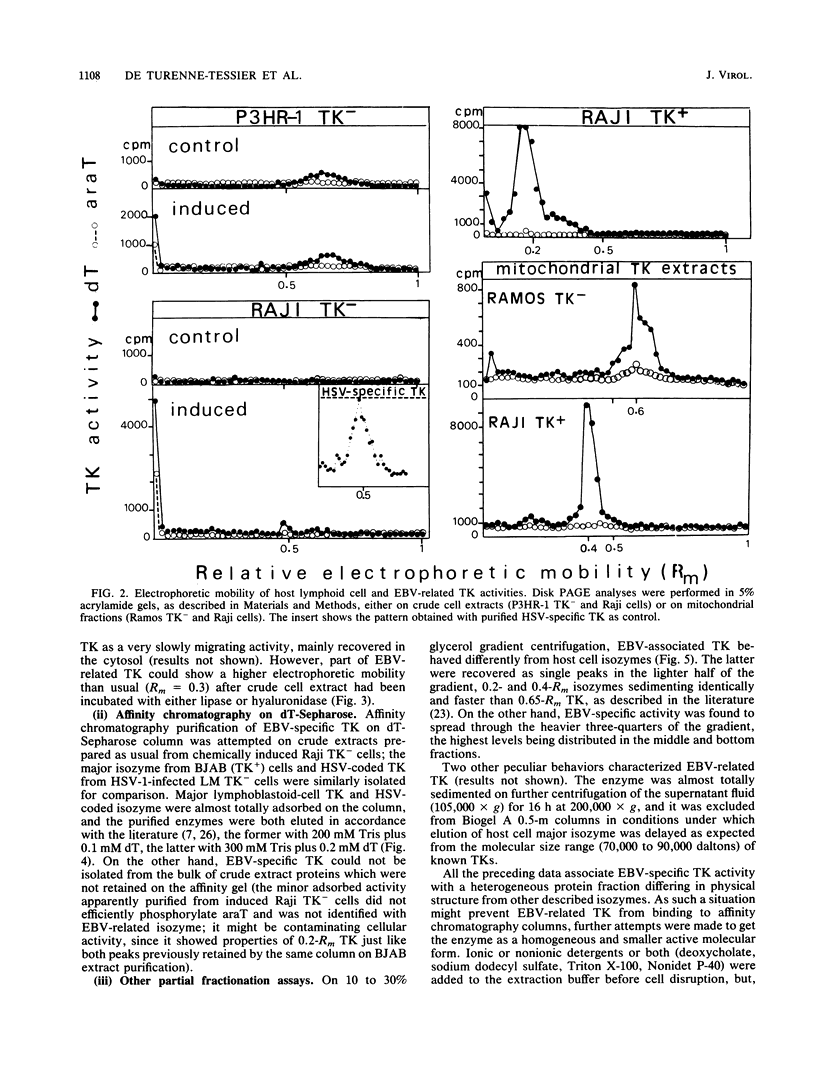
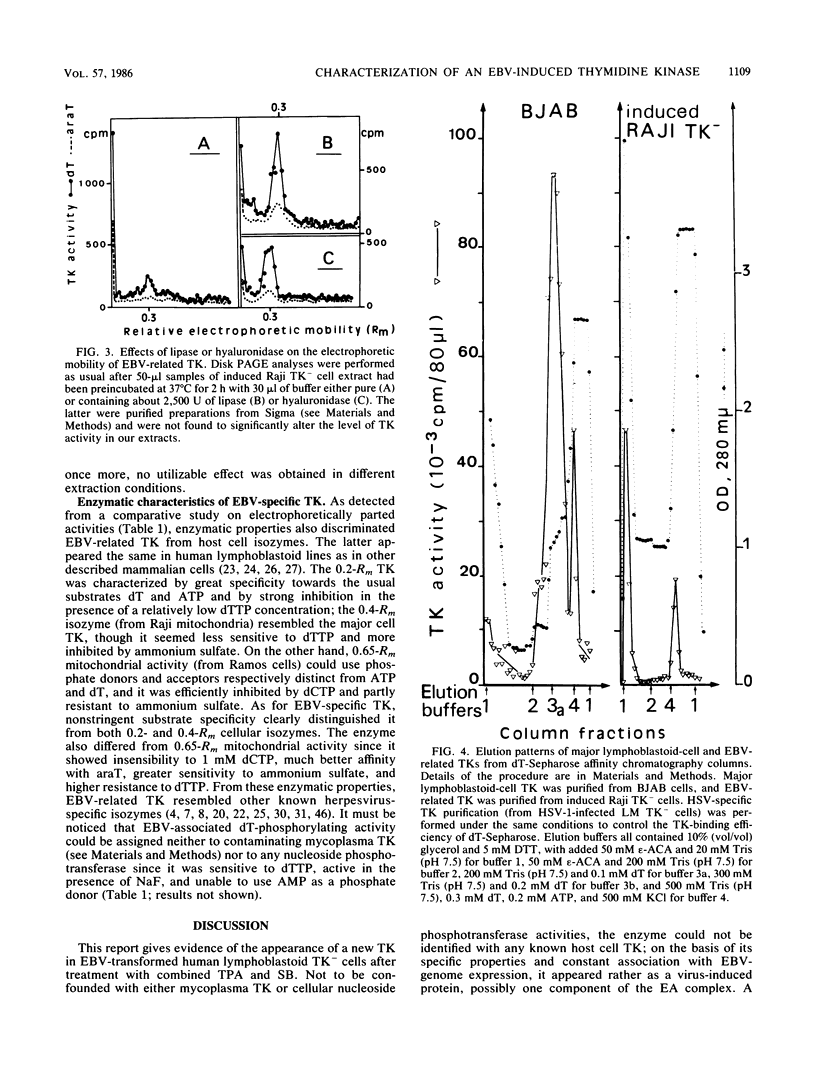
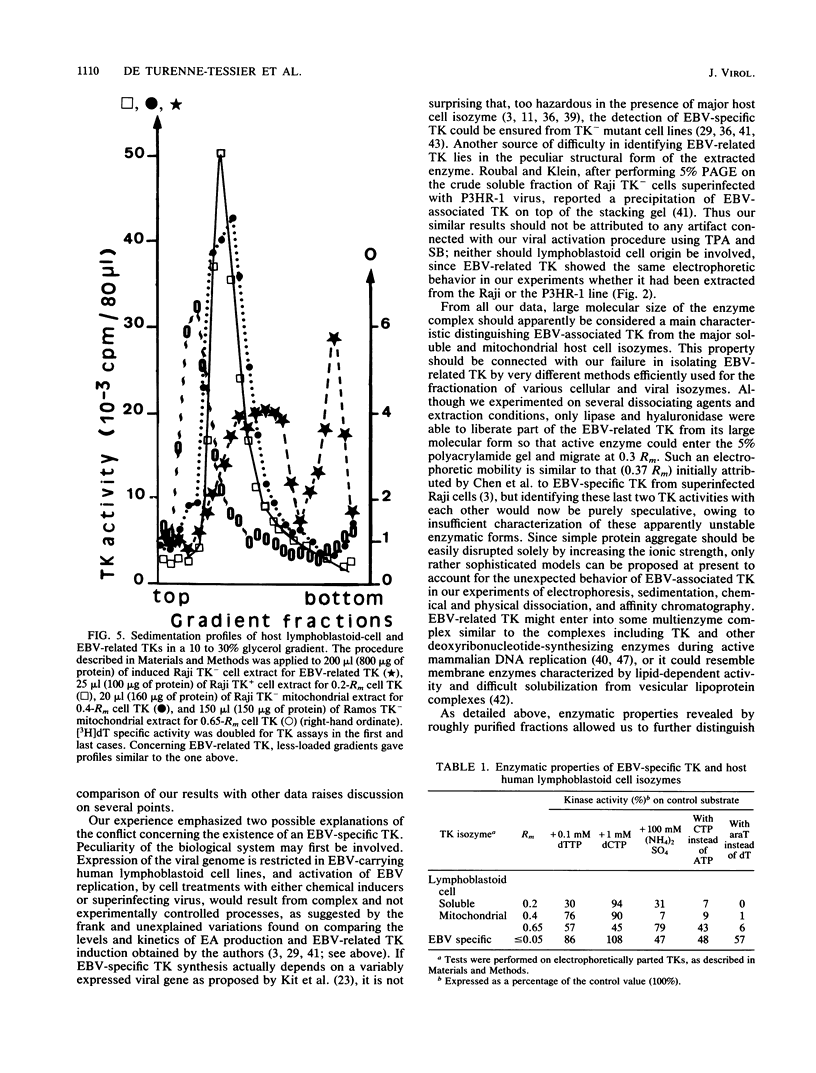
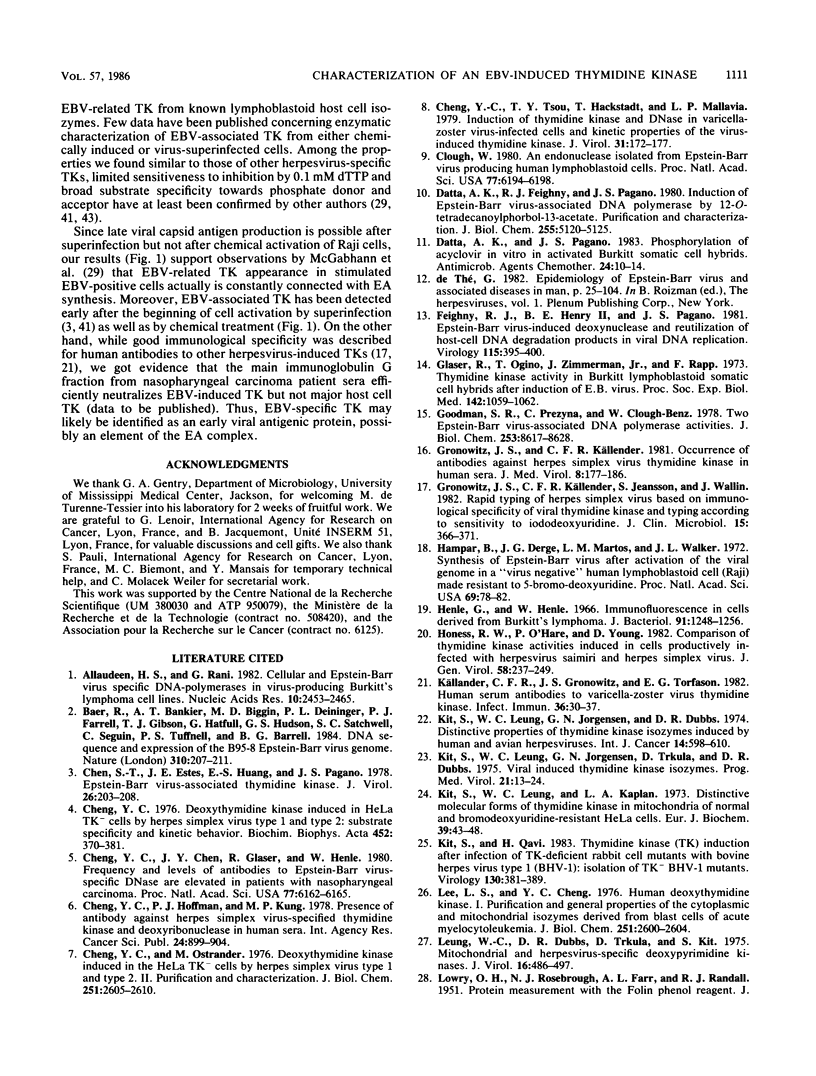
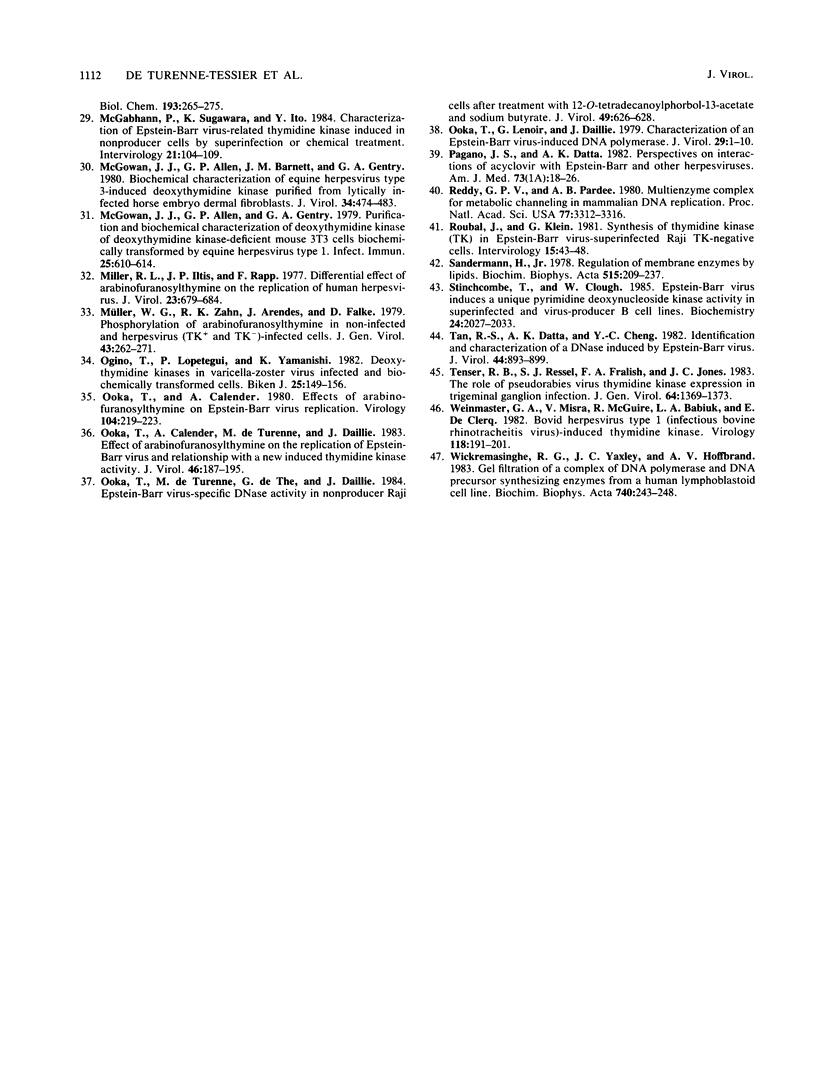
Selected References
These references are in PubMed. This may not be the complete list of references from this article.
- Allaudeen H. S., Rani G. Cellular and Epstein-Barr virus specific DNA polymerases in virus-producing Burkitt's lymphoma cell lines. Nucleic Acids Res. 1982 Apr 10;10(7):2453–2465. doi: 10.1093/nar/10.7.2453. [DOI] [PMC free article] [PubMed] [Google Scholar]
- Baer R., Bankier A. T., Biggin M. D., Deininger P. L., Farrell P. J., Gibson T. J., Hatfull G., Hudson G. S., Satchwell S. C., Séguin C. DNA sequence and expression of the B95-8 Epstein-Barr virus genome. Nature. 1984 Jul 19;310(5974):207–211. doi: 10.1038/310207a0. [DOI] [PubMed] [Google Scholar]
- Chen S. T., Estes J. E., Huang E. S., Pagano J. S. Epstein-Barr virus-associated thymidine kinase. J Virol. 1978 Apr;26(1):203–208. doi: 10.1128/jvi.26.1.203-208.1978. [DOI] [PMC free article] [PubMed] [Google Scholar]
- Cheng Y. C., Chen J. Y., Glaser R., Henle W. Frequency and levels of antibodies to Epstein-Barr virus-specific DNase are elevated in patients with nasopharyngeal carcinoma. Proc Natl Acad Sci U S A. 1980 Oct;77(10):6162–6165. doi: 10.1073/pnas.77.10.6162. [DOI] [PMC free article] [PubMed] [Google Scholar]
- Cheng Y. C. Deoxythymidine kinase induced in the HELA TK- cells by herpes simplex virus type I and type II. Substrate specificity and kinetic behavior. Biochim Biophys Acta. 1976 Dec 8;452(2):370–381. doi: 10.1016/0005-2744(76)90186-8. [DOI] [PubMed] [Google Scholar]
- Cheng Y. C., Hoffmann P. J., Kung M. P. Presence of antibody against herpes simplex virus-specified thymidine kinase and deoxyribonuclease in human sera. IARC Sci Publ. 1978;(24 Pt 2):899–904. [PubMed] [Google Scholar]
- Cheng Y. C., Ostrander M. Deoxythymidine kinase induced in HeLa TK- cells by herpes simplex virus type I and type II. II. Purification and characterization. J Biol Chem. 1976 May 10;251(9):2605–2610. [PubMed] [Google Scholar]
- Cheng Y. C., Tsou T. Y., Hackstadt T., Mallavia L. P. Induction of thymidine kinase and DNase in varicella-zoster virus-infected cells and kinetic properties of the virus-induced thymidine kinase. J Virol. 1979 Jul;31(1):172–177. doi: 10.1128/jvi.31.1.172-177.1979. [DOI] [PMC free article] [PubMed] [Google Scholar]
- Clough W. An endonuclease isolated from Epstein-Barr virus-producing human lymphoblastoid cells. Proc Natl Acad Sci U S A. 1980 Oct;77(10):6194–6198. doi: 10.1073/pnas.77.10.6194. [DOI] [PMC free article] [PubMed] [Google Scholar]
- Datta A. K., Feighny R. J., Pagano J. S. Induction of Epstein-Barr virus-associated DNA polymerase by 12-O-tetradecanoylphorbol-13-acetate. Purification and characterization. J Biol Chem. 1980 Jun 10;255(11):5120–5125. [PubMed] [Google Scholar]
- Datta A. K., Pagano J. S. Phosphorylation of acyclovir in vitro in activated Burkitt somatic cell hybrids. Antimicrob Agents Chemother. 1983 Jul;24(1):10–14. doi: 10.1128/aac.24.1.10. [DOI] [PMC free article] [PubMed] [Google Scholar]
- Feighny R. J., Henry B. E., 2nd, Pagano J. S. Epstein-Barr virus-induced deoxynuclease and the reutilization of host-cell DNA degradation products in viral DNA replication. Virology. 1981 Dec;115(2):395–400. doi: 10.1016/0042-6822(81)90121-5. [DOI] [PubMed] [Google Scholar]
- Glaser R., Ogino T., Zimmerman J., Jr, Rapp F. Thymidine kinase activity in Burkitt lymphoblastoid somatic cell hybrids after induction of the EB virus. Proc Soc Exp Biol Med. 1973 Apr;142(4):1059–1062. doi: 10.3181/00379727-142-37176. [DOI] [PubMed] [Google Scholar]
- Goodman S. R., Prezyna C., Benz W. C. Two Epstein-Barr virus-associated DNA polymerase activities. J Biol Chem. 1978 Dec 10;253(23):8617–8628. [PubMed] [Google Scholar]
- Gronowitz J. S., Källander C. F., Jeansson S., Wallin J. Rapid typing of herpes simplex virus based on immunological specificity of viral thymidine kinase and typing according to sensitivity to iododeoxyuridine. J Clin Microbiol. 1982 Mar;15(3):366–371. doi: 10.1128/jcm.15.3.366-371.1982. [DOI] [PMC free article] [PubMed] [Google Scholar]
- Gronowitz J. S., Källander C. F. Occurrence of antibodies against herpes simplex virus thymidine kinase in human sera. J Med Virol. 1981;8(3):177–186. doi: 10.1002/jmv.1890080304. [DOI] [PubMed] [Google Scholar]
- Hampar B., Derge J. G., Martos L. M., Walker J. L. Synthesis of Epstein-Barr virus after activation of the viral genome in a "virus-negative" human lymphoblastoid cell (Raji) made resistant to 5-bromodeoxyuridine (thymidine kinase-virus antigen-immunofluorescence-herpesvirus fingerprints). Proc Natl Acad Sci U S A. 1972 Jan;69(1):78–82. doi: 10.1073/pnas.69.1.78. [DOI] [PMC free article] [PubMed] [Google Scholar]
- Henle G., Henle W. Immunofluorescence in cells derived from Burkitt's lymphoma. J Bacteriol. 1966 Mar;91(3):1248–1256. doi: 10.1128/jb.91.3.1248-1256.1966. [DOI] [PMC free article] [PubMed] [Google Scholar]
- Honess R. W., O'Hare P., Young D. Comparison of thymidine kinase activities indiced in cells productively infected with herpesvirus saimiri and herpes simplex virus. J Gen Virol. 1982 Feb;58(Pt 2):237–249. doi: 10.1099/0022-1317-58-2-237. [DOI] [PubMed] [Google Scholar]
- Kit S., Leung W. C., Jorgensen G. N., Dubbs D. R. Distinctive properties of thymidine kinase isozymes induced by human and avian hepresviruses. Int J Cancer. 1974 Nov 15;14(5):598–610. doi: 10.1002/ijc.2910140506. [DOI] [PubMed] [Google Scholar]
- Kit S., Leung W. C., Jorgensen G. N., Trkula D., Dubbs D. R. Viral-induced thymidine kinase isozymes. Prog Med Virol. 1975;21:13–34. [PubMed] [Google Scholar]
- Kit S., Leung W. C., Kaplan L. A. Distinctive molecular forms of thymidine kinase in mitochondria of normal and bromodeoxyuridine-resistant HeLa cells. Eur J Biochem. 1973 Nov 1;39(1):43–48. doi: 10.1111/j.1432-1033.1973.tb03101.x. [DOI] [PubMed] [Google Scholar]
- Kit S., Qavi H. Thymidine kinase (TK) induction after infection of TK-deficient rabbit cell mutants with bovine herpesvirus type 1 (BHV-1): isolation of TK- BHV-1 mutants. Virology. 1983 Oct 30;130(2):381–389. doi: 10.1016/0042-6822(83)90092-2. [DOI] [PubMed] [Google Scholar]
- Källander C. F., Gronowitz J. S., Torfason E. G. Human serum antibodies to varicella-zoster virus thymidine kinase. Infect Immun. 1982 Apr;36(1):30–37. doi: 10.1128/iai.36.1.30-37.1982. [DOI] [PMC free article] [PubMed] [Google Scholar]
- Lee L. S., Cheng Y. C. Human deoxythymidine kinase. I. Purification and general properties of the cytoplasmic and mitochondrial isozymes derived from blast cells of acute myelocytic leukemia. J Biol Chem. 1976 May 10;251(9):2600–2604. [PubMed] [Google Scholar]
- Leung W. C., Dubbs D. R., Trkula D., Kit S. Mitochondrial and herpesvirus-specific deoxypyrimidine kinases. J Virol. 1975 Sep;16(3):486–497. doi: 10.1128/jvi.16.3.486-497.1975. [DOI] [PMC free article] [PubMed] [Google Scholar]
- Mac Gabhann P., Sugawara K., Ito Y. Characterization of Epstein-Barr virus-related thymidine kinase induced in nonproducer cells by superinfection or chemical treatment. Intervirology. 1984;21(2):104–109. doi: 10.1159/000149508. [DOI] [PubMed] [Google Scholar]
- McGowan J. J., Allen G. P., Barnett J. M., Gentry G. A. Biochemical characterization of equine herpesvirus type 3-induced deoxythymidine kinase purified from lytically infected horse embryo dermal fibroblasts. J Virol. 1980 May;34(2):474–483. doi: 10.1128/jvi.34.2.474-483.1980. [DOI] [PMC free article] [PubMed] [Google Scholar]
- McGowan J. J., Allen G. P., Gentry G. A. Purification and biochemical characterization of deoxythymidine kinase of deoxythymidine kinase-deficient mouse 3T3 cells biochemically transformed by equine herpesvirus type 1. Infect Immun. 1979 Aug;25(2):610–614. doi: 10.1128/iai.25.2.610-614.1979. [DOI] [PMC free article] [PubMed] [Google Scholar]
- Miller R. L., Iltis J. P., Rapp F. Differential effect of arabinofuranosylthymine of the replication of human herpesviruses. J Virol. 1977 Sep;23(3):679–684. doi: 10.1128/jvi.23.3.679-684.1977. [DOI] [PMC free article] [PubMed] [Google Scholar]
- Müller W. E., Zahn R. K., Arendes F., Falke D. Phosphorylation of arabinofuranosylthymine in non-infected and herpesvirus (TK+ and TK-)-infected cells. J Gen Virol. 1979 May;43(2):261–271. doi: 10.1099/0022-1317-43-2-261. [DOI] [PubMed] [Google Scholar]
- Ogino T., Lopetegui P., Yamanishi K. Deoxythymidine kinases in varicella-zoster virus infected and biochemically transformed cells. Biken J. 1982 Sep;25(3):149–156. [PubMed] [Google Scholar]
- Ooka T., Calender A. Effects of arabinofuranosylthymine on Epstein-Barr virus replication. Virology. 1980 Jul 15;104(1):219–223. doi: 10.1016/0042-6822(80)90379-7. [DOI] [PubMed] [Google Scholar]
- Ooka T., Calender A., de Turenne M., Daillie J. Effect of arabinofuranosylthymine on the replication of Epstein-Barr virus and relationship with a new induced thymidine kinase activity. J Virol. 1983 Apr;46(1):187–195. doi: 10.1128/jvi.46.1.187-195.1983. [DOI] [PMC free article] [PubMed] [Google Scholar]
- Ooka T., De Turenne M., De The G., Daillie J. Epstein-Barr virus-specific DNase activity in nonproducer Raji cells after treatment with 12-o-tetradecanoylphorbol-13-acetate and sodium butyrate. J Virol. 1984 Feb;49(2):626–628. doi: 10.1128/jvi.49.2.626-628.1984. [DOI] [PMC free article] [PubMed] [Google Scholar]
- Ooka T., Lenoir G., Daillie J. Characterization of an Epstein-Barr virus-induced DNA polymerase. J Virol. 1979 Jan;29(1):1–10. doi: 10.1128/jvi.29.1.1-10.1979. [DOI] [PMC free article] [PubMed] [Google Scholar]
- Pagano J. S., Datta A. K. Perspectives on interactions of acyclovir with Epstein-Barr and other herpes viruses. Am J Med. 1982 Jul 20;73(1A):18–26. doi: 10.1016/0002-9343(82)90057-2. [DOI] [PubMed] [Google Scholar]
- Prem veer Reddy G., Pardee A. B. Multienzyme complex for metabolic channeling in mammalian DNA replication. Proc Natl Acad Sci U S A. 1980 Jun;77(6):3312–3316. doi: 10.1073/pnas.77.6.3312. [DOI] [PMC free article] [PubMed] [Google Scholar]
- Roubal J., Klein G. Synthesis of thymidine kinase (TK) in Epstein-Barr virus-superinfected Raji TK-negative cells. Intervirology. 1981;15(1):43–48. doi: 10.1159/000149213. [DOI] [PubMed] [Google Scholar]
- Sandermann H., Jr Regulation of membrane enzymes by lipids. Biochim Biophys Acta. 1978 Sep 29;515(3):209–237. doi: 10.1016/0304-4157(78)90015-1. [DOI] [PubMed] [Google Scholar]
- Stinchcombe T., Clough W. Epstein-Barr virus induces a unique pyrimidine deoxynucleoside kinase activity in superinfected and virus-producer B cell lines. Biochemistry. 1985 Apr 9;24(8):2027–2033. doi: 10.1021/bi00329a034. [DOI] [PubMed] [Google Scholar]
- Tan R. S., Datta A. K., Cheng Y. C. Identification and characterization of a DNase induced by Epstein-Barr virus. J Virol. 1982 Dec;44(3):893–899. doi: 10.1128/jvi.44.3.893-899.1982. [DOI] [PMC free article] [PubMed] [Google Scholar]
- Tenser R. B., Ressel S. J., Fralish F. A., Jones J. C. The role of pseudorabies virus thymidine kinase expression in trigeminal ganglion infection. J Gen Virol. 1983 Jun;64(Pt 6):1369–1373. doi: 10.1099/0022-1317-64-6-1369. [DOI] [PubMed] [Google Scholar]
- Weinmaster G. A., Misra V., McGuire R., Babiuk L. A., DeClercq E. Bovid herpesvirus type-1 (infectious bovine rhinotracheitis virus)-induced thymidine kinase. Virology. 1982 Apr 15;118(1):191–201. doi: 10.1016/0042-6822(82)90332-4. [DOI] [PubMed] [Google Scholar]
- Wickremasinghe R. G., Yaxley J. C., Hoffbrand A. V. Gel filtration of a complex of DNA polymerase and DNA precursor-synthesizing enzymes from a human lymphoblastoid cell line. Biochim Biophys Acta. 1983 Aug 2;740(3):243–248. doi: 10.1016/0167-4781(83)90132-x. [DOI] [PubMed] [Google Scholar]


